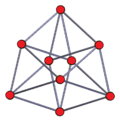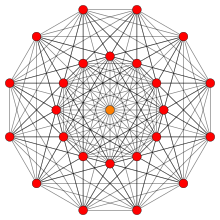2 22 honeycomb
| 222 honeycomb | |
|---|---|
| (no image) | |
| Type | Uniform tessellation |
| Coxeter symbol | 222 |
| Schläfli symbol | {3,3,32,2} |
| Coxeter diagram | |
| 6-face type | 221 |
| 5-face types | 211 {34} |
| 4-face type | {33} |
| Cell type | {3,3} |
| Face type | {3} |
| Face figure | {3}×{3} duoprism |
| Edge figure | {32,2} |
| Vertex figure | 122 |
| Coxeter group | , [[3,3,3<sup>2,2</sup>]] |
| Properties | vertex-transitive, facet-transitive |
In geometry, the 222 honeycomb is a uniform tessellation of the six-dimensional Euclidean space. It can be represented by the Schläfli symbol {3,3,32,2}. It is constructed from 221 facets and has a 122 vertex figure, with 54 221 polytopes around every vertex.
Its vertex arrangement is the E6 lattice, and the root system of the E6 Lie group so it can also be called the E6 honeycomb.
Construction
It is created by a Wythoff construction upon a set of 7 hyperplane mirrors in 6-dimensional space.
The facet information can be extracted from its Coxeter–Dynkin diagram, ![]()
![]()
![]()
![]()
![]()
![]()
![]()
![]()
![]() .
.
Removing a node on the end of one of the 2-node branches leaves the 221, its only facet type, ![]()
![]()
![]()
![]()
![]()
![]()
![]()
![]()
![]()
The vertex figure is determined by removing the ringed node and ringing the neighboring node. This makes 122, ![]()
![]()
![]()
![]()
![]()
![]()
![]() .
.
The edge figure is the vertex figure of the vertex figure, here being a birectified 5-simplex, t2{34}, ![]()
![]()
![]()
![]()
![]() .
.
The face figure is the vertex figure of the edge figure, here being a triangular duoprism, {3}×{3}, ![]()
![]()
![]() .
.
Kissing number
Each vertex of this tessellation is the center of a 5-sphere in the densest known packing in 6 dimensions, with kissing number 72, represented by the vertices of its vertex figure 122.
E6 lattice
The 222 honeycomb's vertex arrangement is called the E6 lattice.[1]
The E62 lattice, with [[3,3,3<sup>2,2</sup>]] symmetry, can be constructed by the union of two E6 lattices:
-








 ∪
∪ 








The E6* lattice[2] (or E63) with [3[32,2,2]] symmetry. The Voronoi cell of the E6* lattice is the rectified 122 polytope, and the Voronoi tessellation is a bitruncated 222 honeycomb.[3] It is constructed by 3 copies of the E6 lattice vertices, one from each of the three branches of the Coxeter diagram.
-








 ∪
∪ 







 ∪
∪ 







 = dual to
= dual to 







 .
.
Related honeycombs
The 222 honeycomb is one of 127 uniform honeycombs (39 unique) with symmetry. 24 of them have doubled symmetry [[3,3,3<sup>2,2</sup>]] with 2 equally ringed branches and, and 7 have sextupled (3!) symmetry [3[32,2,2]] with identical rings on all 3 branches. There are no regular honeycombs in the family since its Coxeter diagram a nonlinear graph, but the 222 and birectified 222 are isotopic, with only one type of facet: 221, and rectified 122 polytopes respectively.
| Symmetry | Order | Honeycombs |
|---|---|---|
| [32,2,2] | Full |
8: |
| [[3,3,3<sup>2,2</sup>]] | ×2 |
24:
|
| [3[32,2,2]] | ×6 |
7: |
Birectified 2 22 honeycomb
The birectified 2 22 honeycomb ![]()
![]()
![]()
![]()
![]()
![]()
![]()
![]()
![]() , has within its symmetry construction 3 copies of
, has within its symmetry construction 3 copies of ![]()
![]()
![]()
![]()
![]()
![]()
![]() facets. Its facets are centered on the vertex arrangement of E6* lattice, as:
facets. Its facets are centered on the vertex arrangement of E6* lattice, as:
-








 ∪
∪ 







 ∪
∪ 








Geometric folding
The group is related to the by a geometric folding, so this honeycomb can be projected into the 4-dimensional 16-cell honeycomb.
| {3,3,32,2} | {3,3,4,3} |
k22 polytopes
The 222 honeycomb, is fourth in a dimensional series of uniform polytopes, expressed by Coxeter as k22 series. The final is a paracompact hyperbolic honeycomb, 322. Each progressive uniform polytope is constructed from the previous as its vertex figure.
| Space | Finite | Euclidean | Hyperbolic | ||
|---|---|---|---|---|---|
| n | 4 | 5 | 6 | 7 | 8 |
| Coxeter group |
2A2 | A5 | E6 | =E6+ | =E6++ |
| Coxeter diagram |
|||||
| Symmetry | [[3<sup>2,2,-1</sup>]] | [[3<sup>2,2,0</sup>]] | [[3<sup>2,2,1</sup>]] | [[3<sup>2,2,2</sup>]] | [[3<sup>2,2,3</sup>]] |
| Order | 72 | 1440 | 103,680 | ∞ | |
| Graph |  |
 |
 |
∞ | ∞ |
| Name | −122 | 022 | 122 | 222 | 322 |
The 222 honeycomb is third in another dimensional series 22k.
| Space | Finite | Euclidean | Hyperbolic | |
|---|---|---|---|---|
| n | 5 | 6 | 7 | 8 |
| Coxeter group |
A5 | E6 | =E6+ | E6++ |
| Coxeter diagram |
||||
| Graph |  |
 |
∞ | ∞ |
| Name | 220 | 221 | 222 | 223 |
Notes
References
- Coxeter The Beauty of Geometry: Twelve Essays, Dover Publications, 1999, ISBN 978-0-486-40919-1 (Chapter 3: Wythoff's Construction for Uniform Polytopes)
- Coxeter Regular Polytopes (1963), Macmillan Company
- Regular Polytopes, Third edition, (1973), Dover edition, ISBN 0-486-61480-8 (Chapter 5: The Kaleidoscope)
- Kaleidoscopes: Selected Writings of H.S.M. Coxeter, edited by F. Arthur Sherk, Peter McMullen, Anthony C. Thompson, Asia Ivic Weiss, Wiley-Interscience Publication, 1995, ISBN 978-0-471-01003-6 GoogleBook
- (Paper 24) H.S.M. Coxeter, Regular and Semi-Regular Polytopes III, [Math. Zeit. 200 (1988) 3–45]
- R. T. Worley, The Voronoi Region of E6*. J. Austral. Math. Soc. (A), 43 (1987), 268-278.
- Conway, John H.; Sloane, Neil J. A. (1998). Sphere Packings, Lattices and Groups ((3rd ed.) ed.). New York: Springer-Verlag. ISBN 0-387-98585-9. p125-126, 8.3 The 6-dimensional lattices: E6 and E6*
| Fundamental convex regular and uniform honeycombs in dimensions 3–10 (or 2-9) | |||||
|---|---|---|---|---|---|
| Family | / / | ||||
| Uniform tiling | {3[3]} | δ3 | hδ3 | qδ3 | Hexagonal |
| Uniform convex honeycomb | {3[4]} | δ4 | hδ4 | qδ4 | |
| Uniform 5-honeycomb | {3[5]} | δ5 | hδ5 | qδ5 | 24-cell honeycomb |
| Uniform 6-honeycomb | {3[6]} | δ6 | hδ6 | qδ6 | |
| Uniform 7-honeycomb | {3[7]} | δ7 | hδ7 | qδ7 | 222 |
| Uniform 8-honeycomb | {3[8]} | δ8 | hδ8 | qδ8 | 133 • 331 |
| Uniform 9-honeycomb | {3[9]} | δ9 | hδ9 | qδ9 | 152 • 251 • 521 |
| Uniform 10-honeycomb | {3[10]} | δ10 | hδ10 | qδ10 | |
| Uniform n-honeycomb | {3[n]} | δn | hδn | qδn | 1k2 • 2k1 • k21 |